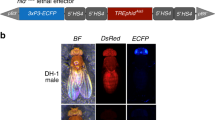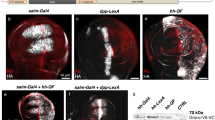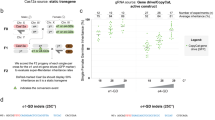Abstract
Germline transformation systems for nearly 20 insect species have been derived from transposable elements, allowing the development of transgenic insects for basic and applied studies1,2,3. These systems use a defective nonautonomous vector that results in stable vector integrations after the disappearance of transiently provided transposase helper plasmid4, which is essential to maintain true breeding lines and consistent transgene expression that would otherwise be lost after vector remobilization. The risk of remobilization by an unintended transposase source has so far not been a concern for laboratory studies, but the prospective use of millions of transgenic insects in biocontrol programs will likely increase the risk, therefore making this a critical issue for the ecological safety of field release programs5,6. Here we describe an efficient method that deletes a terminal repeat sequence of a transposon vector after genomic integration. This procedure prevents transposase-mediated remobilization of the other terminal sequence and associated genes, ensuring their genomic stability.
This is a preview of subscription content, access via your institution
Access options
Subscribe to this journal
Receive 12 print issues and online access
$209.00 per year
only $17.42 per issue
Buy this article
- Purchase on Springer Link
- Instant access to full article PDF
Prices may be subject to local taxes which are calculated during checkout


Similar content being viewed by others
References
Handler, A.M. A current perspective on insect gene transfer. Insect Biochem. Mol. Biol. 31, 111–128 (2001).
Handler, A.M. & O'Brochta, D.A. Transposable elements for insect transformation. in Comprehensive Insect Physiology. Biochemistry, Pharmacology, and Molecular Biology (eds. Gilbert, L.I., Iatrou, K. & Gill, S.) in press (Elsevier Limited, Oxford, UK, 2004).
Atkinson, P.W. & James, A.A. Germline transformants spreading out to many insect species. Adv. Genet. 47, 49–86 (2002).
Rubin, G.M. & Spradling, A.C. Genetic transformation of Drosophila with transposable element vectors. Science 218, 348–353 (1982).
Hoy, M.A. Transgenic arthropods for pest management programs: risks and realities. Exp. Appl. Acarol. 24, 463–495 (2000).
Handler, A.M. Understanding and improving transgene stability and expression in insects for SIT and conditional lethal release programs. Insect Biochem. Mol. Biol. 34, 121–130 (2004).
Finnegan, D.J. Transposable elements. Curr. Opin. Genet. Dev. 2, 861–867 (1992).
Handler, A.M. & Harrell, R.A. Polyubiquitin-regulated DsRed marker for transgenic insects. Biotechniques 31, 820–828 (2001).
Horn, C. & Wimmer, E.A. A versatile vector set for animal transgenesis. Dev. Genes Evol. 210, 630–637 (2000).
Horn, C., Schmid, B.G., Pogoda, F.S. & Wimmer, E.A. Fluorescent transformation markers for insect transgenesis. Insect Biochem. Mol. Biol. 32, 1221–1235 (2002).
Handler, A.M. & Harrell, R.A. Germline transformation of Drosophila melanogaster with the piggyBac transposon vector. Insect Mol. Biol. 8, 449–458 (1999).
Spradling, A.C. P-element-mediated transformation. in Drosophila: A Practical Approach (ed. Roberts, D.B.) 175–197, (IRL Press, Oxford, UK, 1986).
Hartl, D.L. & Ochman, H. Inverse polymerase chain reaction. Methods Mol. Biol. 58, 293–301 (1996).
Altschul, S.F. et al. Gapped BLAST and PSI-BLAST: a new generation of protein database search programs. Nucleic Acids Res. 25, 3389–3402 (1997).
Mullins, M.C., Rio, D.C. & Rubin, G.M. Cis-acting DNA sequence requirements for P-element transposition. Genes Dev. 3, 729–738 (1989).
Cui, Z., Geurts, A.M., Liu, G., Kaufman, C.D. & Hackett, P.B. Structure-function analysis of the inverted terminal repeats of the Sleeping Beauty transposon. J. Mol. Biol. 318, 1221–1235 (2002).
Li, X., Lobo, N., Bauser, C.A. & Fraser, M.J. Jr. The minimum internal and external sequence requirements for transposition of the eukaryotic transformation vector piggyBac. Mol. Genet. Genomics 266, 190–198 (2001).
Neuhaus, M.J. Additional data on crossing over between X and Y chromosomes in Drosophila melanogaster. Genetics 22, 333–339 (1937).
Rong, Y.S. & Golic, K.G. Site-specific recombination for the genetic manipulation of transgenic insects. in Insect Transgenesis: Methods and Applications (eds. Handler, A.M. & James, A.A.) 53–75, (CRC Press, Boca Raton, FL, 2000).
Lozovsky, E.R., Nurminsky, D., Wimmer, E.A. & Hartl, D.L. Unexpected stability of mariner transgenes in Drosophila. Genetics 160, 527–535 (2002).
Hoy, M.A. Deploying transgenic arthropods in pest management programs: risks and realities. in Insect Transgenesis: Methods and Applications (eds. Handler, A.M. & James, A.A.) 335–368, (CRC Press, Boca Raton, FL, 2000).
Sundararajan, P., Atkinson, P.W. & O'Brochta, D.A. Transposable element interactions in insects: crossmobilization of hobo and Hermes. Insect Mol. Biol. 8, 359–368 (1999).
O'Brochta, D.A. & Atkinson, P.W. Transposable elements and gene transformation in non-drosophilid insects. Insect Biochem. Mol. Biol. 26, 739–753 (1996).
Hartl, D.L., Lohe, A.R. & Lozovskaya, E.R. Modern thoughts on an ancyent marinere: function, evolution, regulation. Annu. Rev. Genet. 31, 337–358 (1997).
Robertson, H.M. & Lampe, D.J. Distribution of transposable elements in arthropods. Annu. Rev. Entomol. 40, 333–357 (1995).
Bushman, F . Lateral DNA Transfer (Cold Spring Harbor Laboratory Press, Cold Spring Harbor, NY, 2002).
Handler, A.M. & McCombs, S.D. The piggyBac transposon mediates germ-line transformation in the Oriental fruit fly and closely related elements exist in its genome. Insect Mol. Biol. 9, 605–612 (2000).
Acknowledgements
Grateful appreciation is extended to Rod Nagoshi for discussions on the development of stabilization vectors and to the US Department of Agriculture–National Research Initiative Competitive Grants Program for support of this research.
Author information
Authors and Affiliations
Corresponding author
Ethics declarations
Competing interests
The authors declare no competing financial interests.
Rights and permissions
About this article
Cite this article
Handler, A., Zimowska, G. & Horn, C. Post-integration stabilization of a transposon vector by terminal sequence deletion in Drosophila melanogaster. Nat Biotechnol 22, 1150–1154 (2004). https://doi.org/10.1038/nbt1002
Received:
Accepted:
Published:
Issue Date:
DOI: https://doi.org/10.1038/nbt1002
This article is cited by
-
Unpredictable recombination of PB transposon in Silkworm: a potential risk
Molecular Genetics and Genomics (2021)
-
Improvement on the genetic engineering of an invasive agricultural pest insect, the cherry vinegar fly, Drosophila suzukii
BMC Genetics (2020)
-
An efficient strategy for producing a stable, replaceable, highly efficient transgene expression system in silkworm, Bombyx mori
Scientific Reports (2015)
-
Remobilizing deleted piggyBac vector post-integration for transgene stability in silkworm
Molecular Genetics and Genomics (2015)
-
Not all GMOs are crop plants: non-plant GMO applications in agriculture
Transgenic Research (2014)



